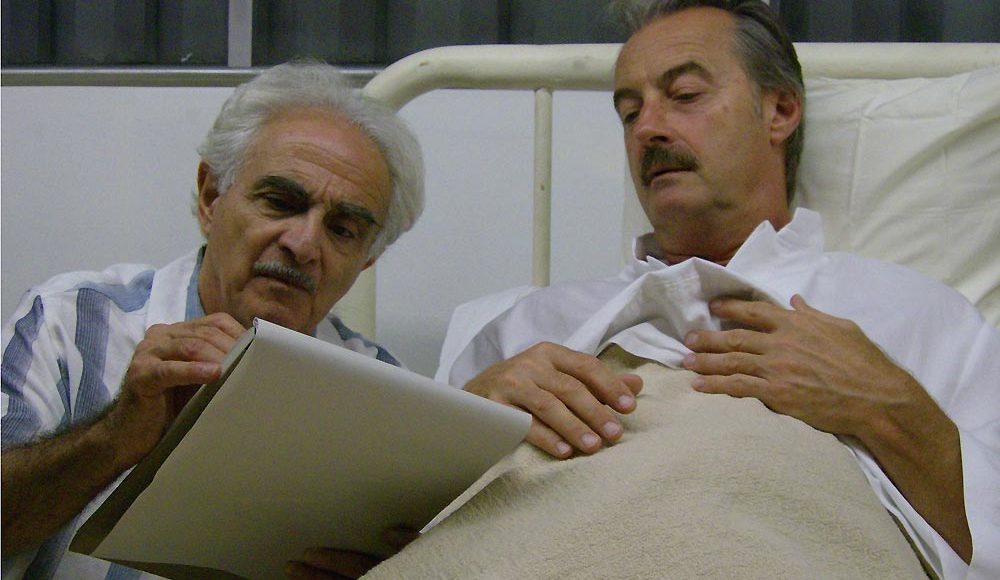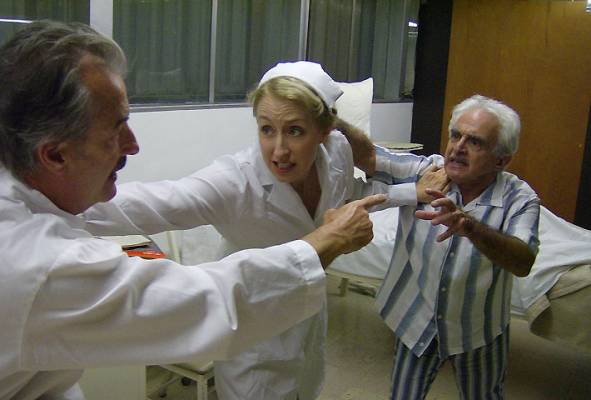Here you have reviews of two shows The Princes of Kings Road at the Neutra Institute Museum and Gallery, and Café Society at the Odyssey Ensemble Theatre. I suggest you read them jointly as both function in revealing the strengths and flaws of the other. Along the way I promise to disclose some secrets to success in tackling theatrical productions and will share as well perhaps more L.A. history than you would expect. But if you’re game, then push on brave reader!
♦ ♦ ♦
It’s actually very straightforward as to what divides the exceptional product from the mediocre.
It’s a half an inch.
Hold your hand up in front of your face, estimate that measurement using the thumb and index finger and look at it.
A half inch, that’s all.
That means you go a “half inch” farther than was expected of you.
That means you give any task a “half inch” more than it needs to complete.
That you invest a “half inch” more thought into any answer you arrive at.
There’s the difference between a fizzle and something that dazzles, just the application of that “half inch”; of course in order for it to work you have to apply it to each and every decision and aspect of your show, every single last one from the very first to the very last.
What? You thought you only needed to apply it once? Are you, nuts? A half inch is nothing it’s not even an inch!
But they do add up. Deliberation and commitment.
The productions of The Princes of Kings Road and Café Society share some cross over features. Both are set in Los Angeles, both deal with the longing of people to connect with others, both employ projections, both productions faced many of the same difficulties, both were undertaken by husband and wife teams.
There, though, all similarity ends.
Overall The Princes of Kings Road and playwright and director Tom Lazarus had to contend with the greater challenges, the foremost being an exceedingly tricky venue.
But despite the many stumbling blocks in its path, The Princes of Kings Road succeeds on every level. One suspects it is because Lazarus and his producer Stevie Stern Lazarus applied the “half inch” principle with unceasing diligence.
The story told is based on an actual occurrence.
Richard Neutra and R.M. Schindler were two Viennese expatriate architects who settled in Los Angeles during the 1920’s and for five years shared both a residence and a studio on Kings Road in West Hollywood, hence the play’s title.
Playwright Lazarus takes up the story nearly thirty years after their partnership ended.
The two men, after long individual careers, are thrown together by chance when they find themselves sharing a hospital room in 1953.
Lazarus has approached this event as two old lions, separated by decades of animosity and bitterness, thrown suddenly together by fate, and forced to come to terms with their legacies while simultaneously confronting their own mortality.
Lazarus has constructed his work on honest moments from honest emotions. These are recognizable, and by such his characters are acceptable.
As Lazarus also presents in the piece a brief history of L.A. architecture it is appropriate that the show is being staged in one of Neutra’s own structures, originally designed as an office space, now the Neutra Institute Museum and Gallery of Silverlake.
A playwright directing his own show is always a risky route to set upon.
His pacing is a tad tepid, but this appears to be by choice rather than fault. As for the playing area’s limitations, Lazarus addresses this by limiting his playing areas.
Lazarus adroitly sidesteps every pitfall in his path which speaks well of both his and his producer’s attentiveness in approaching this project.
It also bodes well for Rod Menzies and Carole Real of the Ensemble Studio Theatre/LA, their first production after taking up the duties of artistic directors in the wake of Gates McFadden’s departure last year.
The play itself, while not a spectacular achievement, is both intelligently written and superbly crafted.
At the helm, Lazarus skillfully pulls off the two paramount demands placed on any director; he doesn’t obscure the merits of the material he is working from, and he casts the perfect actors.
Ron Sossi of the Odyssey once described the rehearsal process to me as, “the time you try to correct the mistakes you made in casting.”
Lazarus avoided any such mistakes.
If you have no interest in architecture and could care less about the problems of two old white guys, the trio of actors on stage here are reason enough to see this production.
John Nielsen, as the arrogant, womanizing Schindler and Raymond Xifo as the more staid Neutra work the script for all its worth and then some. Their performances, invested in the moment and anchored to the firm foundation of well made choices, manage to gloss over any shortcomings that may be found in either the script or venue.
The junior partner in this triumvirate is Heather Robinson as Nurse Rothstein. There is a secret in the handling of a small role, and Ms. Robinson knows what it is.
Okay, quick sidebar:
Actor Richard Garrick was cast in the original 1947 production of A Streetcar Named Desire. His role would be listed in the program as “A Strange Man.” Before it opened on Broadway a friend asked what the play was about.
Garrick answered, “It’s about a doctor who overcomes many hardships to rescue a desperate and frightened woman from a very bad man in order to take her to a place where she’ll be safe.”
Garrick portrayed the doctor who removes Blanche from Stanley and Stella’s home at the play’s end, and to whom Jessica Tandy delivered the classic line, “whoever you are, I have always depended upon the kindness of strangers.”
There you have it. The secret to playing a “small role” is to realize its importance.
Ms. Robinson earns her rightful place in the play itself and shows her merit as an actress by doing this, and turns in a praiseworthy performance in the process.
Lazarus keeps a tight rein in his use of projections, resulting in clarity rather than clutter. Photos of both old L.A., and Neutra and Schindler’s design drawings and finished commissions are used sparingly, helping the audience understand the architectural concepts discussed on stage.
Lazarus is to be commended for daring to expound about the history of L.A. in his piece.
It both fascinates and frustrates me that L.A. is regarded as a city devoid of history, when the exact opposite is the case.
L.A. not only has an enthralling past, but ours, and not the east coast, is where the history of this country starts.
The pathway that boasts the longest record of continuous use in this nation, Wilshire Boulevard; which has been traveled since the Tongva people, a branch of the Uto-Aztecan family, crossed the Bering Strait between 25,000 and 10,000 B.C.E.
Even in architecture L.A. outstrips most other cities.
On the streets and avenues of New York or Chicago one can view perhaps ten or even fifteen different schools of design or architectural movements represented.
In L.A. you have: Greek Revival, Neo-Romanesque, Italianate Style (1860-1870’s), Victorian Style, High Victorian Gothic, Queen Anne (aka Jacobean or Gothic Cottage), Carpenter Gothic, (expressed in wood rather than stone), Eastlake, Second Empire, Monterey Style, Bungalow Style, Chicago Style (Frank Lloyd Wright school), Prairie School, The Shingle Style, French Chateauesque, Colonial Revival, Mission Style-Revival, Spanish Renaissance (Spanish Baroque), Churrigueresque Style, Moorish Style (Islamic), Spanish Colonial Revival, Hansel & Gretel (such as the Spandena House at 516 Walden Dr. in Beverly Hills), Mediterranean Revival Style, Beaux Arts Style, Egyptian Revival (touched off by discovery of King Tut’s tomb in 1922), Italian Renaissance, Craftsman Style, Georgian Style, Tudor Revival, French Renaissance (a good example is the Los Angeles Theatre built in 1931), Mayan Style, Art Deco or Zigzag Moderne (Bullock’s Wilshire & Wiltern Theatre), PWA Moderne (the MGM Studios built in 1938), International Style, Streamline Moderne, American Perpendicular, and that most L.A. of designs Programmatic Architecture.
Los Angeles history is an amazing topic, and if you have an interest in learning more about it or the architecture of this city, then The Princes of Kings Road would be a good place to start.
But if your only interest is in watching skilled actors at work in an engaging and smartly woven work, don’t worry, they’ve got you covered there too.
♦ ♦ ♦
Princes of Kings Road playing now through Oct 4
Neutra Institute and Museum of Silverlake
2379 Glendale Blvd.
Silverlake, CA 90039.
To Order tickets
Call (323) 641-7747 or go to www.ThePrincesofKingsRoad.com






